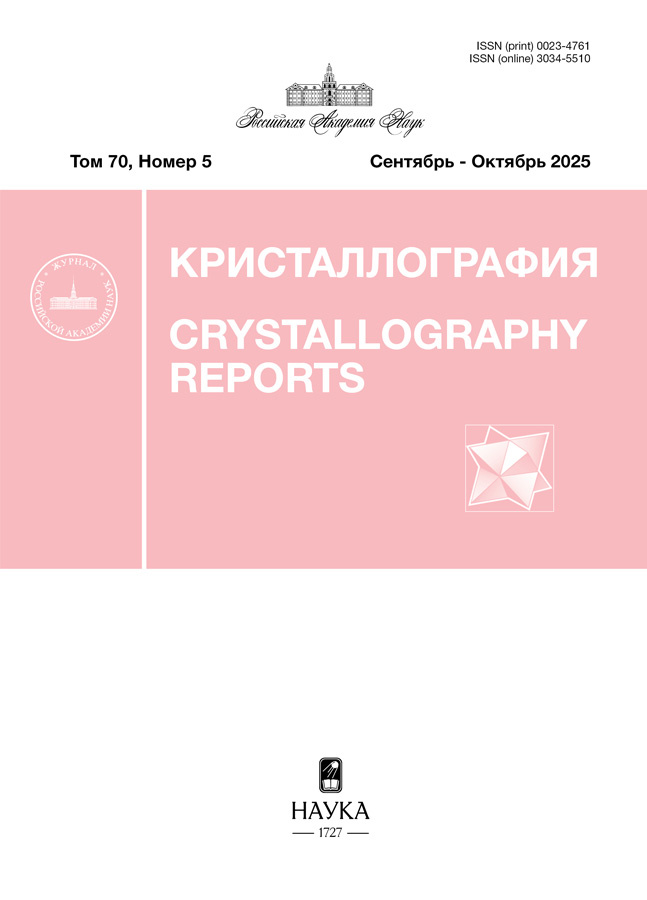Микротрубки ZnO: механизм формирования и лазерный эффект на модах шепчущей галереи
- Авторы: Тарасов А.П.1, Задорожная Л.А.1, Набатов Б.В.1, Каневский В.М.1
-
Учреждения:
- Институт кристаллографии им. А.В. Шубникова Курчатовского комплекса кристаллографии и фотоники НИЦ “Курчатовский институт”
- Выпуск: Том 70, № 1 (2025)
- Страницы: 35-41
- Раздел: ФИЗИЧЕСКИЕ СВОЙСТВА КРИСТАЛЛОВ
- URL: https://modernonco.orscience.ru/0023-4761/article/view/686176
- DOI: https://doi.org/10.31857/S0023476125010058
- EDN: https://elibrary.ru/ITUTWB
- ID: 686176
Цитировать
Полный текст
Аннотация
С помощью фотолюминесцентной спектроскопии исследованы люминесцентные и лазерные свойства микротрубок ZnO, синтезированных модифицированным методом термического испарения. Показано, что лазерная генерация в ближнем УФ-диапазоне возбуждается на модах шепчущей галереи. Продемонстрирована возможность достижения низких порогов лазерной генерации (вплоть до ~8 кВт/см2) и высоких оптических добротностей (свыше 3900). Предложен механизм формирования таких микрокристаллов, основанный на предположении об одновременном росте и травлении вдоль кристаллографического направления [0001].
Полный текст
Об авторах
А. П. Тарасов
Институт кристаллографии им. А.В. Шубникова Курчатовского комплекса кристаллографии и фотоники НИЦ “Курчатовский институт”
Автор, ответственный за переписку.
Email: tarasov.a@crys.ras.ru
Россия, Москва
Л. А. Задорожная
Институт кристаллографии им. А.В. Шубникова Курчатовского комплекса кристаллографии и фотоники НИЦ “Курчатовский институт”
Email: tarasov.a@crys.ras.ru
Россия, Москва
Б. В. Набатов
Институт кристаллографии им. А.В. Шубникова Курчатовского комплекса кристаллографии и фотоники НИЦ “Курчатовский институт”
Email: tarasov.a@crys.ras.ru
Россия, Москва
В. М. Каневский
Институт кристаллографии им. А.В. Шубникова Курчатовского комплекса кристаллографии и фотоники НИЦ “Курчатовский институт”
Email: tarasov.a@crys.ras.ru
Россия, Москва
Список литературы
- Morkoc H., Ozgur U. Zinc oxide: fundamentals, materials and device technology. Weinheim: Wiley-VCH, 2009.
- Sharma D.K., Shukla S., Sharma K.K., Kumar V. // Mater. Today. 2022. V. 49. P. 3028. https://doi.org/10.1016/j.matpr.2020.10.238
- Klingshirn C.F. Semiconductor Optics. Berlin: Springer, 2012.
- Srivastava V., Gusain D., Sharma Y.C. // Ceram. Int. 2013. V. 39. P. 9803. https://doi.org/10.1016/j.ceramint.2013.04.110
- Oprea O., Andronescu E., Ficai D. et al. // Curr. Org. Chem. 2014. V. 18. P. 192.
- Uikey P., Vishwakarma K. // Int. J. Emerg. Tech. Comp. Sci. Electron. 2016. V. 21. P. 239.
- Di Mauro A., Fragalà M.E., Privitera V., Impellizzeri G. // Mater. Sci. Semicond. Process. 2017. V. 69. P. 44. https://doi.org/10.1016/j.mssp.2017.03.029
- Тарасов А.П., Веневцев И.Д., Муслимов А.Э. и др. // Квантовая электроника. 2021. Т. 51. С. 366.
- Znaidi L., Illia G.S, Benyahia S. et al. // Thin Solid Films. 2003. V. 428. P. 257. https://doi.org/10.1016/S0040-6090(02)01219-1
- Dong H., Zhou B., Li J. et al. // J. Materiomics. 2017. V. 3. P. 255. https://doi.org/10.1016/j.jmat.2017.06.001
- Tashiro A., Adachi Y., Uchino T. // J. Appl. Phys. 2023. V. 133. P. 221101. https://doi.org/10.1063/5.0142719
- Xu C., Dai J., Zhu G. et al. // Las. Photon. Rev. 2014. V. 8. P. 469. https://doi.org/10.1002/lpor.20130012
- Yang Y.D., Tang M., Wang F.L. et al. // Photonics Res. 2019. V. 7. P. 594. https://doi.org/10.1364/PRJ.7.000594
- Chen R., Ling B., Sun X.W., Sun H.D. // Adv. Mater. 2011. V. 23. P. 2199. https://doi.org/10.1002/adma.201100423
- Michalsky T., Wille M., Dietrich C.P. et al. // Appl. Phys. Lett. 2014. V. 105. P. 211106. https://doi.org/10.1063/1.4902898
- Qin F., Xu C., Lei D.Y. et al. // ACS Photonics. 2018. V. 5. P. 2313. https://doi.org/10.1021/acsphotonics.8b00128
- Tarasov A.P., Muslimov A.E., Kanevsky V.M. // Photonics. 2022. V. 9. P. 871. https://doi.org/10.3390/photonics9110871
- Тарасов А.П., Задорожная Л.А., Муслимов А.Э. и др. // Письма в ЖЭТФ. 2021. Т. 114. С. 596. https://doi.org/10.31857/S1234567821210035
- Тарасов А.П., Лавриков А.С., Задорожная Л.А., Каневский В.М. // Письма в ЖЭТФ. 2022. Т. 115. С. 554. https://doi.org/10.31857/S1234567822090026
- Tarasov A.P., Zadorozhnaya L.A., Kanevsky V.M. // J. Appl. Phys. 2024. V. 136. P. 073102. https://doi.org/10.1063/5.0214420
- Li L.E., Demianets L.N. // Opt. Mater. 2008. V. 30. P. 1074. https://doi.org/10.1016/j.optmat.2007.05.013
- Демьянец Л.Н., Ли Л.Е., Лавриков А.С., Никитин С.В. // Кристаллография. 2010. Т. 55. С. 149.
- Zadorozhnaya L.A., Tarasov A.P., Lavrikov A.S., Kanevsky V.M. // Comp. Opt. 2024. V. 48. P. 696. https://doi.org/10.18287/2412-6179-CO-1414
- Dong H., Sun L., Xie W. et al. // J. Phys. Chem. C. 2010. V. 114. P. 17369. https://doi.org/10.1021/jp1047908
- Тарасов А.П., Задорожная Л.А., Каневский В.М. // Письма в ЖЭТФ. 2024. Т. 119. С. 875. https://dx.doi.org/10.31857/S1234567824120024
- Wagner R.S. // J. Crystal Growth. 1968. V. 3/4. P. 159.
- Kaldis E. // Crystal Growth and Characterization. Amsterdam: North Holland, 1975.
- Sharma R.B. // J. Appl. Phys. 1970. V. 41. P. 1866. https://doi.org/10.1063/1.1659122
- Tarasov A.P., Muslimov A.E., Kanevsky V.M. // Materials. 2022. V. 15. P. 8723. https://doi.org/10.3390/ma15248723
- Tarasov A.P., Ismailov A.M., Gadzhiev M.K. et al. // Photonics. 2023. V. 10. P. 1354. https://doi.org/10.3390/photonics10121354
- Ozgur U., Alivov Y.I., Liu C. et al. // J. Appl. Phys. 2005. V. 98. P. 41301. https://doi.org/10.1063/1.1992666
- Ghosh M., Ningthoujam R.S., Vatsa R.K. et al. // J. Appl. Phys. 2011. V. 110. P. 054309. https://doi.org/10.1063/1.3632059
- Zhang Z., Yates Jr. J.T. // Chem. Rev. 2012. V. 112. P. 5520. https://doi.org/10.1021/cr3000626
- Guo B., Qiu Z.R., Wong K.S. // Appl. Phys. Lett. 2003. V. 82. P. 2290. https://doi.org/10.1063/1.1566482
- Dai J., Xu C.X., Wu P. et al. // Appl. Phys. Lett. 2010. V. 97. P. 011101. https://doi.org/10.1063/1.3460281
- Тарасов А.П., Брискина Ч.М., Маркушев В.М. и др. // Письма в ЖЭТФ. 2019. Т. 110. С. 750. https://doi.org/10.1134/S0370274X19230073
- Zimmler M.A., Bao J., Capasso F. et al. // Appl. Phys. Lett. 2008. V. 93. P. 051101. https://doi.org/10.1063/1.2965797
- Czekalla C., Sturm C., Schmidt-Grund R. et al. // Appl. Phys. Lett. 2008. V. 92. P. 241102. https://doi.org/10.1063/1.2946660
- Wiersig J. // Phys. Rev. A. 2003. V. 67. P. 023807. https://doi.org/10.1103/PhysRevA.67.023807
- Liu J., Lee S., Ahn Y. et al. // Appl. Phys. Lett. 2008. V. 92. P. 263102. https://doi.org/10.1063/1.2952763
Дополнительные файлы

















